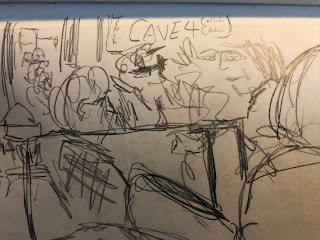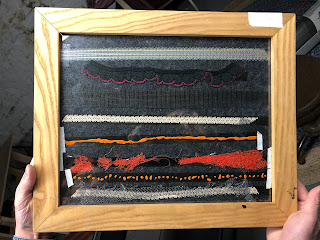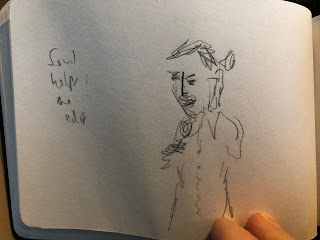Often I'll go to a screening of short films after the sun
has set and the sheer number and variety of them, and the fact that after
sunset I always seem to be fighting sleep, will completely defy my memory. What
did I see and hear, and how do I made sense of it now as that experience is
fading into the distance? I like to take notes, but the notes I take in the
dark are almost always unreadable when the lights have turned on. But those
notes sometimes do help me pull out some moments and impressions, some bits of
the experience, that I can attempt to put into readable words after the fact,
when the sun is rising.
The fourth CAVE Festival of Cinematic, Audio and Visual
Experimentation began at Bryant Lake Bowl on the last day of January 2020.
The first program featured Nazli Dinçel
of Milwaukee, both films that she made and films she selected that others had
made. The program started with her film, "Untitled," which was about
film exhibition, a view from the booth with headset jocks running the show
insulting the program being presented and everyone around them. It's a trip
into the mind of someone hostile to experimental films who is actually the one
showing those movies to an audience.
She partly throws us off by putting her
subtitles on the top of the frame rather than the bottom.
The other films of hers also used subtitles, but never
leaving them in a sub-postion. Often they are directly on the center, and made
by scratching the emulsion off the film or even typing on the film with a
typewriter. Sometimes the words on screen don't match the words we hear, but by
the time we even realize that, the words and sounds of them are gone and we're
left questioning both our eyes and ears. Her last film, "Instructions on
How to Make a Film," shows us how to make a movie by growing a garden.
Her camera is often pointed straight down at the ground, or
into a mirror that may or may not pull away to show what actually is in front
of us. Her program was called "Do Not Look At The Picture," which is
the hardest thing to do in a dark room where they only thing you can see is the
bright image on the screen. But it was exactly what her movies were saying to
us, as well as the others she chose to show.
Joyce Wieland's "Solidarity" showed us a Canadian
cookie company strike through the shoes of the strikers. Greta Snyder's
"Futility" presented the story of an abortion with happy archive
images of people working. And George Landow's "New Improved Institutional
Quality: In the Environment of Liquids and Nasals a Parasitic Vowel Sometimes
Develops," probably cannot even be explained, but has some of the greatest
baffled eyebrow acting to ever grace the screen.
The second program Friday night was all local shorts and
there were so many of them, my notes are such indecipherable scratch, I lost
the little piece of paper that listed the program, and it was late for me -
because of all that I am left to scramble for what was even there, which was
backwards muscles on a beach, Goldilocks danced by a forest, a Lynchian dream
of orange wigs, Richard Nixon lying opera, the delicious embarrassment of
seeing one of my own movies on that screen, a fireworks of young faces, a life
told by a circle, a wrestling match between water and forest, and blue bodies
splashing black ink out of yellow water while fashion meets the wizard of oz
meets prayers of snow angels, and so much more.
On Saturday, I was one of the people who took a cyanotype
filmmaking workshop with Margaret Rorison, whose work would be featured in the
Saturday night program. Sam Hoolihan and John Marks were also there to guide
us. We dipped short strips of film into a chemical that left an iron-based
emulsion on the film. We then placed flat or flatish objects on the film such as lace, dryer lint, other pieces of film, plants, clay,
pressed it under glass, and then exposed the strips of film to UV light for
more than a half hour. The slow exposure time meant that we could place our
objects on the film under low light without exposing it.
After the UV exposure, we developed the image in water and
then spliced all our short strips together to project a work of white ghosts on
blue.
Rorison's program that evening did not feature any
cyanotypes, but like the small objects pressed on the film and then blow up to
the screen, her films got close, close to the worn brick, manholes, shiny concrete
and falling walls of Baltimore, close to her grandmother's hands and face,
close to the walls and shadows of Los Angeles. Even her shots of vineyard rows,
jets in the sky, and windmills felt intimate.
She also showed us a film made by the radiation released by
the Fukishima Nuclear disaster and a family tree made with a real tree, films
by Tomonari Nishikawa and Brue Baillie.
She said she likes to walk with her camera and observe. The
next day, at the Walker Art Center, she showed us her mother's hands in a piece
that she optically printed. She said it was all about her love of the process.
Love of the work and the struggle to make it was the subject
of the Sunday panel, which included Rorison, Dinçel, local filmmaker Richard
Wiebe, and University of Iowa students Trevon Coleman and Michael Wawzenek, all
of whom showed a film, a part of a film, or a work in progress and then talked
about they struggle to make work while trying to work to make a living. It was
an intimate conversation in the rows of the Walker's Mediatheque while a line
of chairs, a microphone and table sat empty in the front as if they were the
real audience.
And then, after some food and drinks at the attached cafe,
everyone went their ways to keep on doing and exploring in all their faraway
places however they might manage to do it.







